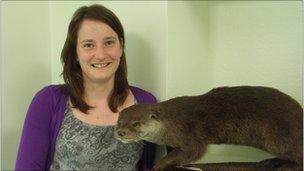Cardiff University Otter Project roadkill study results
- Published

Eleanor Kean said the team were able to study otter signals in more depth than before
Scientists in Wales have shed new light on the social lives of otters by studying roadkill found by the public.
Cardiff University Otter Project says it has made new discoveries about how the animal communicates with scent by studying the glands of 150 dead otters.
The team identified more than 400 chemicals, including some previously thought not to exist in the species.
A spokeswoman said the study would boost efforts to monitor wild otter populations.
The project already knew that otters use scent as their main means of communication, but wanted to learn more about what information was communicated or the social functions of the scent.
With otters notoriously hard to find, the team, based at Cardiff's School of Biosciences, appealed to the public to send in any dead otters they came across.
With help from Dr Carsten MĆ¼ller, a chemical ecologist, and Eleanor Kean, a postgraduate researcher, the team led by Dr Elizabeth Chadwick, uncovered a complex mix of 432 chemicals.
The team said it found:
Pronounced differences in scent depending on age and gender
Learned to successfully distinguish between adult and juvenile otter scents.
Differences between male and female scents in adult otters, but not in the juveniles, which suggests that scent plays a role in attracting mates.
The biggest difference was between pregnant or lactating female otters and male or juvenile otters.
'More depth'
Male otters are known to kill cubs, so mothers are likely to be very secretive. Females are reported to deposit their faeces in water, possibly to hide the differences in scent.
Ms Kean, who led the scent research, said: "We have been able to study the complexity and variety of otter signals in far more depth than has been possible in the past."
The research suggests that scent plays a role in otters attracting mates
"Our findings are a first step to better understanding of otter scent communication, which could help in the future to better monitor wild populations of the species."
She said they were grateful to members of the public, the Environment Agency and RWE npower who helped with the project.
Amanda Best, an Environment Agency biodiversity specialist in Yorkshire, said it was "great news" that experts now know there are differences in otter scents.
"Otters are returning to our region because there are good fish stocks in our rivers," she said.
"This in turn is an indicator of good water quality."
The team's findings have just been published in the journal Chemical Senses.